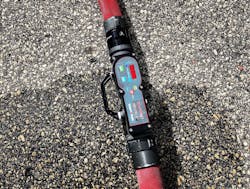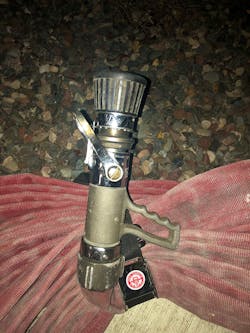Engine Essentials: Achieving Rapid-Dominance Fire Flows
Many researchers and subject matter experts (SMEs) agree that 1¾-inch interior handline flows should be between 150–160 gpm. The NFPA included a similar recommendation in NFPA 1710: Standard for the Organization and Deployment of Fire Suppression Operations, Emergency Medical Operations, and Special Operations to the Public by Career Fire Departments. The standard states that departments should be able to achieve an “effective water flow application rate of 300 gpm from two handlines, each of which has a minimum flow rate of 100 gpm with each handline” for a “structure fire in a typical 2,000-square-foot, two-story single-family dwelling without basement.” It is important to note that the average size of single-family dwellings has trended upward in recent years.
Despite UL Firefighter Safety Research Institute (UL FSRI) studies, many members of the fire service believe that lower flows are acceptable, if not desirable, citing arguments that range from hoseline management to water damage. Many departments across the country flow less than the recommended 150–160 gpm from their 1¾-inch attack packages. There is no doubt that fires can be and have been extinguished with less than 150 gpm. This leads to statements at tailboard debriefs, such as “the fire went out, and no one got hurt.” Every fire goes out eventually, thus extinguishment doesn’t provide a solid metric for the safety and efficiency of the fire attack. Unfortunately, past luck on the fireground reinforces bad policy.
Critical flow rates
To rapidly achieve knock-down, the water application rate must meet or exceed the heat that’s produced by the fire as well as what is contained in the compartment: the critical flow rate. If fire streams are applied at a lesser rate, the fire continues to burn until either the fuel or oxygen is consumed enough so that the stream is sufficient to suppress it. In addition, the flow rate should have a built-in margin of safety to ensure that the handline can combat any unforeseen rapid-fire growth. As crews progress into the structure, it’s vital that they cool the environment, because their point of entry now is a ventilation opening. This can result in a rapid change in fire conditions. The 2010 UL study, “Impact of Ventilation on Fire Behavior in Legacy and Contemporary Residential Construction,” found that the minimum time from ventilation, including door entry, to firefighter untenability averaged 100 seconds in a one-story house and 200 seconds in a two-story house.
The rate of water application should seek to change the environment for the better in no more than 100 seconds to help to ensure occupant and firefighter safety. To do this, the critical flow rate must be met, and the stream must reach the main body of fire. If the engine company just hits rollover, they are treating the symptom and not the root cause. Crews should commit to the space and continue to cool their advance to the main body of fire. If crews fail to reach a point where they can apply water directly on the main body of fire, conditions will continue to deteriorate in the structure. Hoselines must be selected during incident size-up that can deliver the critical flow rate and be rapidly advanced to the main body of fire, in no more than 100 seconds to achieve rapid dominance of the environment.Rapid-dominance doctrine
Departments should research and set policy for target flow rates of the various size handlines on their apparatus. Once policies are in place, departments must flow-test their attack packages to ensure that their hoselines, nozzles and discharge pressures comply with the targets that they set. When selecting a handline on scene, it’s essential that the company officer evaluate smoke conditions, fire conditions, occupancy type and size of the structure. The goal is to select a handline that rapidly overwhelms the heat that’s trapped and being produced inside of the structure.
This tactically overwhelming rate of application draws close parallels to the military strategy doctrine that’s known as rapid dominance, which was developed by Harlan Ullman and James Wade, Jr. Ullman and Wade released their doctrine in a 1996 report to the National Defense University, titled “Shock and Awe: Achieving Rapid Dominance.” The authors wrote, “‘Rapid’ implies the ability to ‘own’ the dimension of time—moving more quickly than an opponent, operating within his decision cycle, and resolving conflict favorably in a short period of time. ‘Dominance’ means the ability to control a situation totally.
“Rapid dominance must be all-encompassing. It will require the means to anticipate and to counter all opposing moves. It will involve the capability to deny an opponent things of critical value … It will imply more than the direct application of force. It will mean the ability to control the environment and to master all levels of an opponent’s activities …”
An engine company at a structure fire must strive to move faster than the fire and to apply water before the fire has time to react to the increased oxygen that results from ventilation. It is critical that companies that are on scene control the entire environment and directly apply water to the seat of the fire while controlling and coordinating ventilation. The water that’s applied must be at or above the critical flow rate to sufficiently cool the environment and control the situation. These actions on the fireground sufficiently meet Ullman and Wade’s key objectives and allow for rapid searches and extinguishment.Modern fire research
As part of the rapid-dominance doctrine, Ullman and Wade cited the need “to maximize knowledge of the environment, of the adversary, and of our own forces …” The UL FSRI has been conducting numerous full-scale fire stream experiments to increase the fire service’s knowledge of the fire environment, our adversary and water application. The recent “Study of the Impact of Fire Attack Utilizing Interior and Exterior Streams on Firefighter Safety and Occupant Survival” provides key data to reinforce the rapid-dominance doctrine. It also dispels some of the common fire service myths of applying too much water and causing water damage.
Several key bullet points of the study center around the importance of rapidly applying water of sufficient quantity to the correct location. The study noted, “the sooner the stream enters the compartment, the sooner the temperatures are reduced. This is largely due to hose streams being limited to line of sight.” Further, “It does not take a large amount of water to absorb the energy being released and knock back the fire. Although less is not necessarily better, when a water supply has not been established, or in areas where no municipal supply exists, water application should not be delayed to establish a water supply.” The timing of stream application to the seat of the fire is critical to reducing the temperatures throughout the structure, making the environment more tenable for victims and firefighters alike—thus emphasizing the rapidity portion of the rapid-dominance doctrine.
The study also notes, “During the 25 suppression experiments conducted, using a 1¾-inch handline flowing 150–165 gpm, the most water utilized for initial knock-back and suppression was less than 250 gallons. When attacking a single room and contents fire, in a residential structure, knock-back and initial suppression is often possible with less than 100 gallons, in some instances less than 75 gallons.” This reinforces the concept that higher rates of application don’t equate necessarily to more water damage, as the fire just goes out that much more quickly because of increased gallons per minute rapidly exceeding the heat production. The key to preventing undue water damage is to shut the bale when initial suppression is achieved.
Finally, the UL FSRI study notes that more water is better—thus proving the overwhelming force concept of the rapid-dominance doctrine. The study reiterated the benefits of cooling the environment on the advance to the main body of fire: “In instances where an interior suppression is chosen, more water used on the approach to the fire relates directly to more tenable conditions for potential trapped occupants and suppression crews.” Further, “The effectiveness of the cooling increased as both the flow rate and the ability of the stream to penetrate further and reach more surfaces increased. The most effective method at reducing temperatures and maintaining them lower the longest was the straight-stream pattern at 150 gpm flowing in a ‘wall, ceiling, wall’ pattern toward the fire compartment.” This study solidifies with data the need to have effective rapid-dominance fire flows in the range of 150–165 gpm.
SMEs and research
It is vitally important that fire departments evaluate their current attack packages to ensure that those packages meet the recommended flow rates as defined by SMEs and scientific research. The rapid-dominance doctrine serves terrifically as a foundation for efforts to greatly improve conditions for victims, to increase firefighter safety and to conserve as much property as possible through rapid extinguishment. One prominent element of the doctrine stands out as something for which every firefighter should continually strive: maximum “knowledge of the environment, of the adversary and our own forces.”
A firefighter’s job is to never stop learning and endeavor to perfect his/her craft.
In the Beginning
To understand how many departments came to adopt their current handline flow rates, one must look at a brief evolutionary history of the fire stream. The capability to direct streams of water onto targets remote from apparatus came to fruition with the invention of fire hose. A September 1998 Firehouse Magazine article that was written by Paul Hashagen, titled “The Development of Fire Hose,” contained a detailed look at the development of fire hose. The first fire hose was constructed in Holland in 1673 of stitched-together leather. In 1807, two Philadelphia firefighters replaced the stitched construction with metal rivets, which allowed greater pressure in the hoselines. In 1821, the first rubber-lined cotton hose was constructed. By 1871, B.F. Goodrich designed a vulcanized lining process. The 1870s were when fire hose in the United States really started to take hold.
Through the 1880s, fire streams consisted mostly of 2½-inch handlines and smooth-bore nozzles. In 1888, John Ripley Freeman conducted a series of fire stream experiments that looked at numerous factors, including the construction of hose, friction loss, tip sizes, flow rates and stream reach. His results were published in “Experiments Relating to Hydraulics of Fire Streams,” which appeared in Transactions of the American Society of Civil Engineers in 1889. Freeman’s work still is the foundation of modern hydraulics in the fire service. The results of similar experiments that pertain to 1½-inch handlines that were conducted by two University of Illinois civil engineering students were released in 1911.
Despite smaller-diameter hose being available, many departments were slow to adopt hose that was smaller than 2½ inches with the exception of booster lines that were on their chemical wagons. In another paper that was published by the University of Illinois in 1918, the author states, “It is frequently recommended that a 250-gpm fire stream be used in business districts, while a 175- or a 200-gpm stream may be used in a residential district. These discharges correspond to a nozzle pressure of 40–50 lbs. per square inch.
Flow rates started to decrease with the implementation of 1½-inch and, eventually, 1¾-inch hose. Chief Lloyd Layman of the Parkersburg, WV, Fire Department presented “Little Drops of Water” at a conference in 1950. Layman promoted his theory that called for exterior fog stream application into confined areas, thus rapidly converting water droplets to steam and displacing the contaminated atmosphere. Layman advocated for application rates of 50–65 gpm for building fires—significantly less than previous recommended flow rates. Layman believed that the rapid conversion to steam would extinguish the fire faster and reduce water damage in the structure.
The insurance industry was involved in research, training and even fire department administration from the late 1800s to the early 1970s. Insurance industry officials were quick to embrace Layman’s techniques as a way to reduce fire losses and to minimize water damage in buildings. The insurance industry served as a means to spread Layman’s theories throughout the country, which resulted in a widespread implementation of fog nozzles and lower flow rates. Around this same time, two researchers at Iowa State University, Keith Royer and Floyd Nelson, looked at how much water applied in the form of fog droplets was needed to control fires in certain size buildings. Royer and Nelson developed a formula that requires fire flow (in gpm) to be equal to the volume of the compartment divided by 100. Royer and Nelson’s research still centered on exterior fog application, but in their research, they introduced to the discussion the idea of critical flow rates, which is crucial to a safe and successful fire attack.
About the Author

Jonathan Hall
Jonathan Hall, who is a Firehouse contributing editor, has more than 24 years of fire service experience. He currently is a captain with the St. Paul, MN, Fire Department assigned to Engine Company 14. Hall also serves as a lead instructor in the department's Training Division; he teaches hands-on skills to members of all ranks. Hall is the co-owner of Make The Move Training LLC and teaches engine company operations throughout the country.


